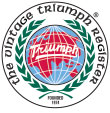TR6 Thrust Washer Check & Installation
by James Davis, jhdavis6@juno.com
TR6 thrust washers tend to wear themselves out in short order, and sometimes require replacement even after as few as 50,000 miles. A common problem with them is that they can easily be installed backwards, in which case they wear out VERY fast, even in as little as a few thousand miles.
This article describes first how to quickly check to see if your thrust washers may need replacement, and then how to make sure they are installed the right way ’round.
Checking the Thrust Washers
Checking the condition of the thrust washers is quite straightforward, and doesn’t even require opening up anything on the engine! This is a good check to repeat every few thousand miles, as letting worn thrust washers continue to wear away can require a different crankshaft and block if the condition is severe enough.
To check, simply push the crankshaft pulley rearward as hard as you can, then have an assistant sit in the car. Now, use your hand to span the space between the crank pulley and the front of the engine, and inform your assistant to lightly step on the clutch pedal. You’ll feel the crank pulley move forward slightly, and this will reveal the condition of the thrust washers.
The allowable axial play for the crankshaft is .007-.013 If the distance seems greater than say, the thickness of your fingernail, you should bargain for a lower price, knowing that you’ll have to be into the lower end of the motor soon. If the distance approaches 1/8″, you can bet that the thrust washers have fallen into the oil pan, and the connecting rod bearings are short to fail. In this case, a different engine may be in order.
Installing the Thrust Washers the Right Way ‘Round
Since I’ve replaced these, and my oil pan contains nothing more than Castrol 20w-50 and my crank doesn’t move about unnecessarily, I’ll quote from page 36, Chapter 1, sec. 45, par. 8 of the Haynes’ manual:
Rotate the crankshaft in the direction toward the main bearing tabs(so that the main bearing shells don’t slide out). At the same time feed the thrust washers into their locations with their oil grooves outwards away from the bearing (photo). [bold type added for emphasis] The photo shows a thrust washer half being inserted with the oil grooves facing toward the inside of the engine.
Now for the confusion: Page 132 of the Bentley manual has an illustration (of a photo on page 36 of the Haynes manual) which shows the grooves facing toward the outside of the engine. The illustration is obviously in error, as the original photo has no oil grooves showing and the text in the Bentley manual reads as follows:
Insert the thrust bearings into the grooves in the cylinder block ensuring that the oil grooves face towards the sides of the crankshaft journal.
This is a very good example of why I prefer the Haynes book, but use the Bentley manual as a reference.
Jim Davis
Fortson, GA
’75 TR6 CF38690UO
’75 TR6 CF37325U
